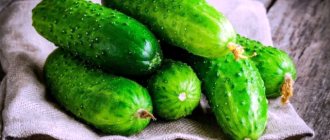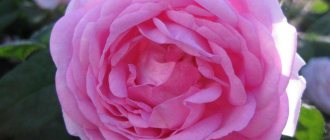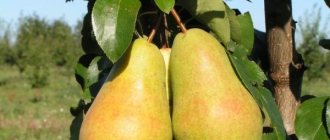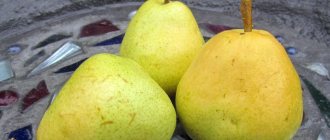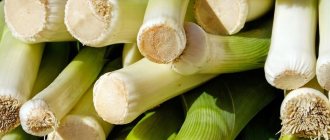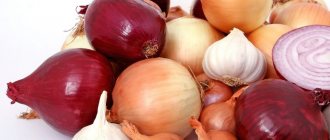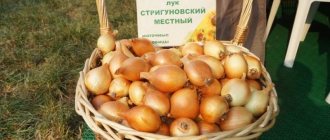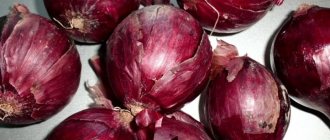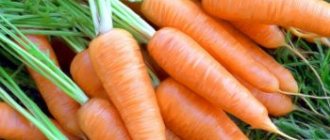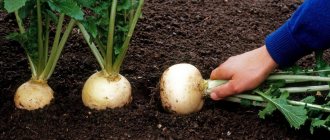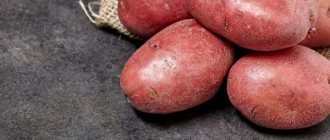There are more than a dozen edible types of onions. And if you have already decided on the varieties of onions or garlic (and they also belong to this genus) planted in your summer cottage, why not think about growing leeks?
It was actively cultivated as a food and medicinal plant back in Ancient Greece and Egypt, in medieval Europe it was held in high esteem on the tables of the rich, and today housewives value leek for its subtle delicate taste, abundance of vitamins C, E, PP and healthy potassium salts, calcium, sodium, phosphorus, iron.
Well, should you give it a place in your garden beds? And we will tell you the most successful and delicious varieties of pearl onions (this is its second name), which will definitely grow successfully in the conditions of the middle zone in general and the Moscow region in particular.
Leek varieties are divided into two large groups - early/mid-season and mid-season/late. The former grow quickly (80-130 days), have large, flat, light green or green leaves and a thick white “stalk” (the base of the stem, which is most prized in cooking). The latter ripen more slowly (180-200 days) and are distinguished by a shorter stem and thin blue-green leaves with a noticeable waxy coating. Study our Top 11!
Leek Goliath
It belongs to the mid-early varieties - you can start harvesting after 120 days, from July.
High-yielding. It is characterized by a large height (22-28 cm of the white part) and thickness (5-6 cm) of the stem. Weight of the product part is 150-200 g. The leaves are of medium width and length, gray-green, the bulb is poorly defined.
It is susceptible to various diseases, so it requires additional attention when caring for it.
The taste is good. The purpose is universal, used both fresh, dried and canned.
Advice from experienced gardeners
To be able to grow leeks on your plot on the first try, use the recommendations of experienced gardeners:
- If the root of the plant was damaged during transfer to open ground, trim the leaves. This will direct forces to restore the root.
- Before transplanting the seedlings, the roots can be coated with a mixture of cow dung and clay in equal proportions. The plant will settle into its new location faster and more firmly.
- The deeper the grooves when planting seedlings, the longer the edible stem of the leek will be.
- When storing onions fresh, check them regularly. Remove dried, yellowed stems, otherwise you risk losing the entire harvest.
Leek Caranta
Refers to mid-late varieties that can be grown in one season - the first selective harvest can begin to be harvested after 125 days (approximately mid-September), it fully ripens in 200 days. It is recommended to grow seedlings (they must be 70 days old at the time of planting in the ground); they can be planted as a winter crop.
High-yielding. The spreading plant is characterized by an average height (10-25 cm of the white part) and thickness (4-5 cm) of the stem. Weight of the product part is 200-300 g. The leaves are long (up to 1 m), gray-green, the bulb is poorly defined.
Semi-sharp, excellent taste. The purpose is universal, used both fresh, dried and canned.
Caring for a plant in open ground
The success of growing a crop, that is, the qualitative and quantitative characteristics of the crop, largely depends on proper care. It must be comprehensive.
Watering
Leeks need regular watering. The crop should be watered abundantly, but not excessively. Use warm water. After transplanting into open ground, watering is not carried out for the first 3 days, then it should be done every 5 days.
During hot dry periods, the frequency of watering should be increased. An average of 12 liters of water is required per square meter of planting.
Top dressing
Feeding is not a prerequisite for growing leeks, but for a rich harvest it should not be ignored. In addition to spring soil preparation, fertilizers are applied 2-3 more times per season. They resort to organic and mineral fertilizers, which are effectively alternated.
The first feeding is carried out 3 weeks after planting in open ground. It is effective to use cow manure or bird droppings. In the first case, you need to take 8 parts of water for one part of fertilizer, in the second - 20 parts.
Weeding and loosening
It is imperative to get rid of weeds. This should be done manually, since chemical methods of weed control are not useful and affect the environmental purity of the product.
Loosening is important for crop development because it provides soil aeration. The plant receives enough oxygen and moisture. Loosening should be carried out once every 1-2 weeks. It is better to do this after watering.
In addition to loosening, hilling is also required. When planting seedlings in the ground, half of the trenches were not filled with soil, so they need to be filled gradually. Such work should be carried out when the culture begins to grow.
Pest and disease control
When growing leeks, like any other crops, it is important to regularly inspect the plantings for diseases and pests. The following problems are possible:
- Onion fly . The main pest that appears from mid-May. The fly lays eggs on leaves and in the soil, and the larvae that emerge from them eat the central part of the plant, causing it to wither and rot. Insecticides or tobacco dust with black pepper and ash are used against the pest. The folk remedy is used for dusting or preparing a solution for spraying.
- Downy mildew . The disease is fungal and is also called peronosporosis. Oval spots appear on the leaves and grow rapidly. The disease must be controlled with fungicides.
- Mosaic . The disease is viral and is transmitted by aphids. Yellow longitudinal spots appear on the leaves, and crop growth slows down. Affected plants should be removed and burned.
- Rust . Fungal disease. Bright yellow spores resembling pads can be seen on the leaves. Gradually they begin to darken and then turn black, the leaves of the plant dry out. To combat the disease, fungicides are used, most often Fitosporin.
Leek Columbus
Refers to early varieties - you can start harvesting after 85 days.
High-yielding. It is characterized by a large height (20-30 cm of the white part) and thickness (5-6 cm) of the stem. Weight of the product part is 300-400 g. The leaves are of medium height (up to 80 cm), width and length, light green, the bulb is poorly defined.
The bleached part is formed virtually without hilling; this variety is cold-resistant and stores well.
Medium-hot, excellent taste. The purpose is universal, used both fresh, dried and canned.
Features of cultivation in different regions
Leeks grow well in all but the coldest climates. However, most varieties have a very long growing season, so you can only be guaranteed to get a full harvest from sowing seeds directly into the garden bed in regions with the warmest climate and long summers. Leeks grow especially slowly in the first one and a half to two months after planting seedlings in the garden: it is during this period that they require special warmth and light.
Of course, it would be possible to use greenhouses, but in the case of leeks, few people do this: they are needed for more heat-loving crops. Therefore, in the southern regions they simply wait until the soil warms up to about +10 °C and sow the seeds in open ground; Most onion varieties manage to produce a full harvest. However, in the conditions of the middle zone, in particular in the Moscow region, it is impossible to do without seedlings. Moreover, this is impossible in Siberia or the Urals, in conditions of a very short summer.
Growing leek seedlings is a painstaking task, but not very difficult.
In harsh climatic regions, early varieties of leek can be successfully grown, however, oddly enough, in Siberia the old winter variety Karantansky remains the most popular. Provided that seeds are sown for seedlings and plants are planted in a bed in a timely manner, it manages to produce a harvest that can be stored for quite a long time. To do this, sowing in boxes is done already in mid-February, and seedlings are planted in the garden at the age of almost three months, when the soil has warmed up sufficiently. Onions are harvested in October, just before the snow falls. When stored correctly (in a cellar, vertically in damp sand), Karantansky is stored until spring. Varieties with the longest growing season are grown only in the southern regions.
By placing leeks in the cellar (vertically in damp sand) they can be stored until spring
Even more successful in terms of obtaining results in regions such as the Urals, Siberia, North-West Russia and even the Moscow region is the use of cold greenhouses, in which onions are grown for the first time - until the onset of heat - and only then the frames are opened. In general, the principles of growing leeks in the Moscow region and colder regions are no different from the generally accepted ones; They only try by any means to extend the warm period for plants.
Leek Vesta
Refers to mid-early varieties - you can start harvesting after 120 days.
High-yielding. It is characterized by a large height (25-50 cm of the white part) and a small thickness (2-3 cm) of the stem. Weight of the product part is 230-350 g. The leaves are tall (up to 140 cm), wide and long, light green, the bulb is poorly defined.
The variety is slightly susceptible to diseases, winter-hardy, heat-resistant. Requires regular hilling and fertilizing.
Sweet, excellent taste. The purpose is universal, used both fresh, dried and canned.
Elephant
Elephant is considered one of the best types of leek among gardeners. After germination, a mid-early plant matures on average on the one hundred and thirtieth day. The elephant is quite large and can reach a height of eighty-five centimeters. It has very wide and bright green leaves with a blue coating, the length of which reaches several tens of centimeters. One plant can weigh up to two hundred grams. Onions are distinguished by excellent productivity: a summer resident can harvest up to four kilograms from one square meter. Elephant loves care and moisture. It needs to be watered, fertilized and hilled. The plant can be stored for up to six months in suitable conditions. In addition, this variety contains a large amount of vitamins and minerals. Elephant is recommended to be included in many dietary dishes.
Leek Elephant
Refers to mid-early varieties - you can start harvesting after 130 days.
High-yielding. It is characterized by a large height (20-30 cm of the white part) and thickness (4-5 cm) of the stem. Weight of the product part is 250-300 g. The leaves are tall (up to 150 cm), wide, bright blue-green, the bulb is poorly defined.
Resistant to high and low temperatures, stores well. Demanding about moisture and hilling, loves feeding.
Spicy, excellent taste. The purpose is universal, used both fresh and dried.
Mid-season
They have a voluminous large stem and are covered with large leaves. Once harvested, it is stored for approximately 2.5 months. You don’t have to collect onions from the beds for the winter, but simply hide them from the cold. In this case, the seeds will ripen next year.
Kazimir
This variety gives a good harvest, but its bulb is small or does not exist at all. It is better to grow it in the spring, using seedlings, regularly watering and feeding.
The length of its false stem is approximately 30 cm, and the leaves are arranged vertically. Kazimir comes dried or simply fresh. It stores well, becoming juicier over time.
Winner
Leek – “Winner” has a juicy stem with a spicy taste. And its greens have a delicate aroma and tenderness.
It ripens in about 4-5 months, everything will depend on the air temperature and the soil in which it was planted. Resistant to frost.
The light part grows approximately 20 cm upward. And the diameter of the stem is approximately 4 cm. The weight of the bulb is approximately 250 grams. The shoots have a grayish color with a blue tint.
Elephant
This variety was bred in the Czech Republic and is planted using seedlings. The development period of the “Elephant” is about 130 days. The plant develops despite frost and heat. True, it needs to be watered and fed regularly. And it is stored for about 2-3 months.
The onion reaches about 1.5 m in height, has large, bright leaves with a greenish-blue tint.
Elephant, with good care, will bring a decent harvest. From an area of 1 sq. m. you can actually get about 4 kilograms of leeks. The plant has a pleasant, rich taste.
It's great to add to appetizers or first courses.
Jolant
Jolant onion grows approximately 35-45 cm tall. Its shoots have rather narrow foliage with a purple tint; the bulbs themselves are small in size. Their false stem is medium in length and small in circumference. The advantage of the variety is its ability to resist fungi.
Kamus (Czech Republic)
The period from planting to ripening for this variety is approximately 5 months.
Its leaves are green in color, concave in shape and covered with a waxy coating on top. The light leg of "Kamus" is small, it is about 20 cm long and approximately 2 cm in diameter. It does not taste too spicy.
Lancelot
A proven variety that has vertically arranged leaves of gray-green color. This onion has a light stem of medium length.
The variety also tolerates low temperatures well, and such onions can be stored for about 2 months. It is better to use it unprocessed.
Leek Tango
Refers to mid-early varieties - you can start harvesting in 115-125 days.
High-yielding. It is characterized by a small height (10-15 cm of the white part) and an average thickness (3-5 cm) of the stem. Weight of the product part is 200-250 g. The leaves are of medium height (up to 70 cm), width and length, dark blue-green, the bulb is poorly defined.
Resistant to low temperatures, pests and fungal diseases, suitable for long-term storage.
Semi-sharp, good taste. The purpose is universal, used both fresh, dried and canned.
Main advantages and disadvantages
Advantages:
- cold-resistant;
- resistant to diseases;
- low calorie;
- a source of iron, calcium, magnesium, B vitamins, as well as PP and E.
Flaws:
- after consumption, like garlic, it gives a specific smell from the mouth;
- may cause flatulence;
- Harmful for people suffering from ulcers or stomach inflammation.
What is the difference from other varieties:
- edible at different stages of development;
- grows leaves until late autumn;
- During storage, the content of ascorbic acid increases.
Beneficial properties for the human body
Regular consumption of leeks helps in the treatment and prevention of the following diseases and conditions :
- atherosclerosis;
- avitaminosis;
- cardiovascular diseases;
- rheumatism;
- gout;
- nervous exhaustion;
- sleep disturbance;
- diseases of the biliary tract;
- decrease in hemoglobin;
- memory impairment;
- metabolic disorders.
Recommended by nutritionists, since 100 g of onion contains only 35 kcal. It is actively used in cosmetology as masks, peeling, hair growth stimulator and dandruff reliever. Strengthens the nail plate, treats sunburn and calluses.
Leek Winner
Refers to mid-season varieties - start harvesting in 130-150 days.
High-yielding. It is characterized by an average height (up to 20 cm of the white part) and an average thickness (3-4 cm) of the stem. Weight of the product part is up to 200 g. The leaves are of medium height (up to 80 cm), width and length, gray-green with a bluish bloom, the bulb is poorly defined.
The variety is frost-resistant.
Slightly spicy, excellent taste. The purpose is universal, used both fresh and dried.
Harm and contraindications
Whatever healing power the plant has, it has some contraindications.
- You should not get carried away with eating leeks, so as not to cause an increase in pressure and acidity of the stomach.
- If you have a duodenal ulcer or an inflammatory process in the stomach, stop eating onions.
- Contraindicated in people suffering from hypoglycemia.
- Essential oils in leeks provoke increased sweating.
Leek Alligator
It belongs to the mid-late varieties - you can start harvesting after 160 days, from September.
High-yielding. It is characterized by a large height (20-30 cm of the white part) and an average thickness (4 cm) of the stem. Weight of the product part is 250-300 g. The leaves are of medium width and length, gray-green, raised, the bulb is poorly defined.
Suitable for growing greens with a delicate taste and pleasant garlic aroma.
Semi-sharp, excellent taste. The purpose is universal, used both fresh, dried and canned.
How to use leek
Leeks are a versatile product. It is used in cooking, folk medicine and home cosmetology. We'll tell you what to do with it later.
Cooking recipes
Due to the delicate taste and the absence of buckwheat inherent in onions, fresh salads are prepared from leeks without prior scalding and soaking in vinegar. The product is good boiled, fried and stewed, does not lose its taste and is combined with fish, meat, poultry, vegetables and cereals. We offer several recipes for leek dishes that will delight even gourmets.
English onion soup
The dish has a rich creamy taste, light aroma of sage and garlic.
Ingredients:
- butter 82.5% - 20 g;
- olive oil - 2 tbsp. l.;
- sprigs of fresh sage - to taste;
- garlic - 5 cloves;
- red onion - 5 pcs.;
- white onion - 5 pcs.;
- leeks - 3 pcs.;
- salt, black pepper - to taste;
- broth (chicken or vegetable) - 2 l;
- baguette - 6-8 slices;
- hard cheese - 150 g;
- Worcestershire sauce - to taste.
Preparation:
- Melt butter in a deep frying pan, pour in 2 tbsp. l. olive oil, add sage and garlic cloves. Cook for 1-2 minutes, stirring constantly.
- Remove the garlic and sage, add the onion cut into rings. Add salt and pepper, stir, cover and simmer for 40–50 minutes, stirring occasionally.
- 20 minutes before the end of cooking, remove the lid to evaporate excess liquid. It should turn caramel color. If necessary, increase the cooking time.
- Pour the broth into the pan, let it boil and cook uncovered for 15–20 minutes.
- Cut the loaf into slices 1 cm thick, dry in a frying pan without oil or on the grill.
- Pour the soup into plates or pots, add bread, grated cheese, and sprinkle with Worcestershire sauce.
- Place in an oven preheated to 200°C. Bake until the cheese has melted.
Pasta with mushrooms, leeks and potato sauce
Unusual potato sauce makes the dish more satisfying. The presented products make a large portion for a company of several people.
Ingredients:
- pappardelle (noodles in the form of wide ribbons) - 500 g;
- leeks - 3 pcs.;
- potatoes - 3 pcs.;
- dry porcini mushrooms - 50 g;
- parmesan - 70 g;
- thyme - 3 sprigs;
- garlic - 3 cloves;
- olive oil - 3 tbsp. l.;
- butter - 20 g;
- black pepper, sea salt - to taste.
Preparation:
- Peel the potatoes and boil in salted water. Then transfer to a bowl, do not drain the broth, it will be useful later.
- Soak the mushrooms in hot water for half an hour or in cold water overnight. Drain the water into a separate container, rinse the mushrooms with running water.
- Finely chop the garlic with a knife and lightly fry in a mixture of olive and butter.
- Squeeze the mushrooms, chop finely and place in a frying pan with garlic, simmer for 20 minutes.
- Cut the leek into rings, simmer some in butter in a separate frying pan, and send some to the mushrooms. Add thyme and pour in 50 ml of boiling water. Cook for 10 minutes.
- Place potatoes and leeks in a blender bowl, pour in 100 ml of potato broth and beat until smooth. Add salt and pepper to taste, and add a little broth if necessary. The consistency of the sauce should resemble thick sour cream.
- Stew mushrooms with leeks until cooked.
- Grate Parmesan on a fine grater.
- Boil the noodles in salted water al dente. Save the remaining cooking water.
- Mix noodles, mushrooms in a saucepan, pour in potato sauce. When serving, sprinkle with Parmesan.
Use in folk medicine
Leeks are used to make home remedies. They eliminate the symptoms of acute respiratory viral infections and activate the body's defenses. The product contains a large amount of vitamin C, known for its strengthening properties.
The recipe for this folk remedy is simple. An arbitrary amount of onion is cut into rings and filled with natural bee honey. The classic recipe uses onions, which have a pungent smell and taste. Leek has no less benefits and is more suitable for this purpose due to its pleasant sweetish taste. Cold medicine is taken 4-5 times a day, 1 tbsp. l. and store no longer than 24 hours.
Leeks increase the secretion of saliva and gastric juice, improve appetite, and normalize the functioning of the liver and gall bladder. A decoction of green feathers has a mild laxative effect and relieves heaviness in the gastrointestinal tract. To do this, pour 200 g of leek into 200 g of boiling water and cook over low heat for 3-5 minutes. Then filter, cool to room temperature and drink 1 glass before bed.
Leek infusion binds and removes free radicals, regulates the functioning of the liver, stomach, prostate gland, and ovaries. To prepare the infusion, the following components are used:
- onion juice - 200 ml;
- leek juice - 100 ml;
- dry white wine - 500 ml;
- calendula (dried flowers) - 1 tsp;
- meadowsweet - 1 tsp;
- chamomile flowers - 1 tsp;
- yarrow - 1 tsp;
- St. John's wort - 1 tsp.
The herbs are mixed, onion juice and wine are added. Cover the container with a lid and leave in a dark place for 1 week. Next, the mixture is filtered through a sieve and the aromatic infusion is taken, 1 tbsp. l. half an hour before meals once a day.
In cosmetology
It has been scientifically proven that regular consumption of leek promotes increased collagen production. The skin of the face becomes elastic, tightened, and the network of small wrinkles disappears.
Onion puree is added to masks for combination and oily skin, hair and nail restoration products.
Leek relieves tension in the legs, softens corns and calluses. The puree is applied to the feet, plastic bags are pulled on, or the feet are wrapped in cling film and the paste is left overnight. In the morning, wash off the mass with warm water, treat the heels with pumice and apply a rich cream.
Onion pulp strengthens the nail plate and hair follicles. Hair acquires a natural shine, becomes stronger and denser. A mask of puree is applied to the roots of the hair, a bath cap is pulled on top, a towel is wrapped around the head and held for 40 minutes. Then the hair is washed with shampoo twice and your favorite mask or balm is applied.
Leek decoction is used to rinse hair. The feathers are poured with water, cooked for 15–20 minutes and left to brew for 3–4 hours. After rinsing, the hair is washed with shampoo. The product eliminates dandruff and regulates the secretion of sebum (sebum).
Leek Premier
It belongs to the mid-late varieties - you can start harvesting after 160 days, from September.
High-yielding. It is characterized by an average height (up to 20 cm of the white part) and an average thickness (4-5 cm) of the stem. Weight of the product part is 380-430 g. The leaves are of medium width and length, blue-green, densely spaced, with a waxy coating, the bulb is poorly defined.
A very winter-hardy variety.
Slightly spicy, excellent taste. The purpose is universal, used both fresh, dried and canned.
Leek Bluewing (Bulgarian)
Refers to late varieties - you can start harvesting after 200 days.
High-yielding. It is characterized by an average height (up to 20 cm of the white part) and an average thickness (4.5-5.5 cm) of the stem. The weight of the product part is about 120-160 g. The leaves are of medium width and length, dense, fan-shaped, dark blue-green, with a strong waxy coating, the bulb is poorly defined.
Very winter-hardy, stores well.
Slightly spicy, excellent taste. The purpose is universal, used both fresh, dried and canned.
Where and how does it grow
Delicious leeks, which may seem very difficult to grow for some, are actually quite unpretentious to the conditions. It can be planted correctly either as seedlings or as seeds. If you plan to grow leeks quickly, it is recommended to germinate its seeds in advance.
It grows well in soil rich in humus, and also prefers a windless and well-lit place. It is better to prepare the area for cultivation in the fall, and fertilize the soil in the spring. The earliest planting begins in the second half of May; late varieties can be planted for the winter.

